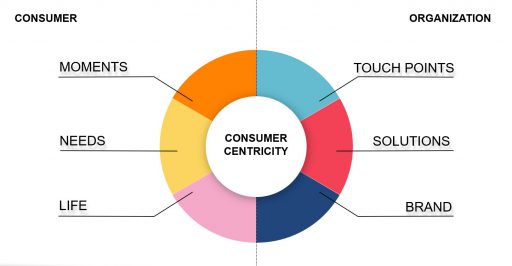3 steps towards a truly consumer-centered organization
Do you think your company is consumer-centered? Think again. Many companies have different practices in place for defining and delivering great consumer experiences, like voice of the customer programs, co-creation, journey mapping, etc. But the question is: do they make a difference? Is this impacting the loyalty of your customers and does this make you stand out from your competitors? Do they truly bring an outside-in approach and make staff members think and act differently?
How? Discover our consumer-centricity model that will enable you to think and act more holistically and move towards becoming a truly consumer-centered company.

Step 1: Understand & manage the moments that matter for your consumers
A few years ago, we collaborated with the Dutch airline KLM to help them define opportunities to improve the transfer experience of their frequent flyers. Through the setup of a Consumer Consulting Board (also known as online research community), we connected with them and asked them to take us along in their transfer experience to understand their frictions and aspirations when transferring. To our surprise we collected plenty of consumer frictions on board before arriving in the airport for transfer, before the on-the-ground transfer services were available. This taught KLM to deal with transfer-related consumer needs way earlier in the journey.
Many companies have this kind of blind spot, overly focusing on improving their existing touchpoint experiences while overseeing to deliver at times when it truly matters for consumers. This issue brings us to the first layer of our consumer centricity model: defining the moments of truth and developing touchpoint experiences to suit these moment, not the other way around.
Step 2: Know how to activate the consumer needs at moments of truth and take your employees on board
Understanding the moments of truth is not enough. Organizations should not forget about the importance of understanding WHY consumers experience things the way they do. KLM understands that travelers are united by their overarching need for discovery, new places, new experiences, new people. Instead of only dealing with basic transferring needs like efficiency, reassurance or control, they activated the need for discovery in the Schiphol transfer experience. Through the Layover with a Local initiative’, transfer passengers can get matched up with a local from Amsterdam for a personal tour through Amsterdam before heading back to the airport for the second leg of their trip. Not the typical transfer experience you expect.
So, organizations need to understand the consumer needs that trigger or surround their products and services. Employees should understand these and feel empowered to define and deliver experiences that address these needs better than the competition. This often requires a dramatic shift in perspective and culture which plays on different levels:
- Hearts: establish a culture of consumer centricity and create a mind shift amongst your employees
- Minds: deliver sparks of fresh consumer needs and inspiration, so that they can use those to craft or reshape strategic plans, product development roadmaps…
- Actions: make sure your employees are supported and empowered to really act upon these needs
To help Dannon win in the space of healthy living, we initiated the Healthy-Minded People community, where consumers that shop for healthy food were gathered and invited to take us along through their shopping experiences. To avoid our report full of insights collecting dust, we actively engaged different key stakeholders on their Insight Activation Studio, a digital platform that helped them to learn from the most meaningful consumer observations and start ideating across teams, over time.
Step 3: Make sure whatever you do is rooted within your brand purpose, easing and trying to improve one’s life with your brand
People are only consumers a small part of the day. To open up opportunities for a brand to provide additional meaning for people, we should play a role in one’s life, not only in the instances where people buy and consume. This often requires companies to think beyond the boundaries of their category. What can you do to ease or improve people’s life?
There are plenty of examples of brands and companies that challenge themselves and deliver beyond what people typically expect from a tourism agency (VisitBritain’s Picture Yourself campaign) or a bank (ASB’s digital piggybank initiative, Clever Kash).
In the end, it’s important that you focus on the bigger WHY: why you are in business as a company? And that is what should define everything you do. So, are you ready to become a truly consumer-centered company?




